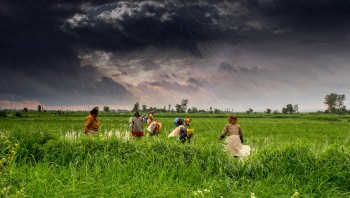Monsoon Intensity Enhanced by Heat Captured by Desert Dust
October 17, 2016

Variations in the ability of sand particles kicked into the atmosphere from deserts in the Middle East to absorb heat can change the intensity of the Indian Summer Monsoon, according to Jackson School research published July 28, 2016, in Scientific Reports, an open access journal from the publishers of Nature.
The Indian monsoon is a period of intense rainfall that more than a billion people rely on to bring rains to farmland. The results of the study could help improve monsoon prediction models, which usually use a constant value for sand particles’ heat-absorbing ability. Because the absorbing ability varies greatly with region and time, assigning a constant heat-absorbing ability for the particles tends to underestimate the impact that absorbed heat can have on the monsoon system, the authors said.
The study was led by Qinjian Jin, a postdoctoral researcher at the Massachusetts Institute of Technology, who conducted the research while earning his Ph.D. at the Jackson School of Geosciences. He collaborated with Zong-Liang Yang, a professor in the Jackson School’s Department of Geological Sciences, and Jiangfeng Wei, a research scientist in the department.
Back to the Newsletter